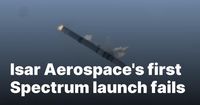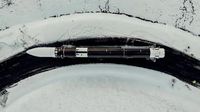On March 30, 2025, the first test flight of Isar Aerospace's Spectrum rocket ended in failure shortly after liftoff from Andøya Spaceport in northern Norway. The launch, which took place at 6:30 a.m. Eastern time, was initially postponed due to unfavorable weather conditions, having a launch window set from March 20 to March 31, 2025, based on a license received from Norwegian regulators just days prior.
The 28-meter Spectrum rocket is a two-stage launch vehicle designed to deploy small and medium-sized satellites into orbit. Unfortunately, within 25 seconds of its ascent, the rocket lost attitude control during a critical maneuver intended to transition from vertical to horizontal flight. This resulted in the vehicle pitching over and plummeting back to Earth, where it ultimately exploded upon impact near the launch pad.
Despite the setback, Isar Aerospace's CEO, Daniel Metzler, expressed a sense of accomplishment. "On our first flight today we got to a clean liftoff, 30 seconds of flight, and didn’t blow up the pad in the meantime," he tweeted shortly after the incident. The test flight, dubbed “Going Full Spectrum,” was intended to gather data and experience from the first integrated test of the rocket's systems.
Metzler had previously stated that the primary goal of the mission was to collect as much information as possible to improve future flights. "That we have the Spectrum on the launch pad is already a great success," he remarked, emphasizing the importance of learning from practical experiments, much like SpaceX has done in its development journey. The rocket's design incorporates advanced manufacturing techniques, including 3D printing, which allows for rapid adjustments and improvements.
Isar Aerospace, based in Munich, has raised over €400 million ($430 million) in funding, including significant investments from notable backers such as Airbus Ventures and the NATO Innovation Fund. The company aims to produce up to 40 launch vehicles annually at a new facility planned for completion in Vaterstetten, east of Munich. The second and third Spectrum rockets are already in production, indicating the company’s commitment to moving forward despite this initial failure.
The Spectrum rocket is engineered to carry up to 1,000 kilograms into low Earth orbit and 700 kilograms into sun-synchronous orbit. Its first stage is powered by nine Aquila engines utilizing liquid oxygen and propane, while the second stage features a single vacuum-optimized Aquila engine. This design is part of Isar Aerospace's strategy to provide a cost-effective solution for launching smaller satellites, which traditionally have relied on larger, more expensive rockets like the Ariane 6.
ESA Director General Josef Aschbacher acknowledged the historic significance of the launch, noting that it represented the first commercial rocket flight from the European mainland. He commented, "Success to get off the pad, and lots of data already obtained. I am sure @isaraerospace will learn a lot. Rocket launch is hard. Never give up, move forward with even more energy!"
The failure of the Spectrum rocket comes at a time when the European Space Agency (ESA) is actively seeking to bolster its capabilities in the small satellite launch market. Just days before the launch, ESA issued a call for proposals in support of new European launch vehicles through the European Launcher Challenge. This initiative aims to identify and fund promising companies in the space sector, with selections to be made at ESA's ministerial conference in November.
While the Spectrum's first flight did not meet its intended objectives, it is crucial to the ongoing development of Isar Aerospace and the broader European space industry. The company is positioned among several European startups, including Rocket Factory Augsburg, which are vying to establish a foothold in the competitive small satellite launch sector. As these companies strive for success, they are contributing to Europe's ambition of achieving independent and cost-effective access to space.
The Andøya Spaceport, utilized since 1962, is the first orbital launch site in continental Europe, marking a significant milestone in the region's space endeavors. Isar Aerospace's commitment to developing a reliable and efficient launch vehicle reflects a growing trend in the aerospace industry, where startups are increasingly looking to fill gaps in the market left by traditional providers.
Looking ahead, Isar Aerospace's focus on rapid development and iteration is evident as they prepare for future test flights. The company is determined to learn from this experience and improve upon its designs and operational protocols. The ambition to produce a fleet of small launch vehicles capable of meeting the needs of satellite operators is a testament to the innovative spirit driving the European space sector.
As the industry faces challenges, Isar Aerospace's journey underscores the importance of resilience and adaptability in the pursuit of technological advancement. The lessons learned from the Spectrum's inaugural flight will undoubtedly inform the next steps in their mission, contributing to the evolution of Europe's capabilities in space exploration and satellite deployment.




